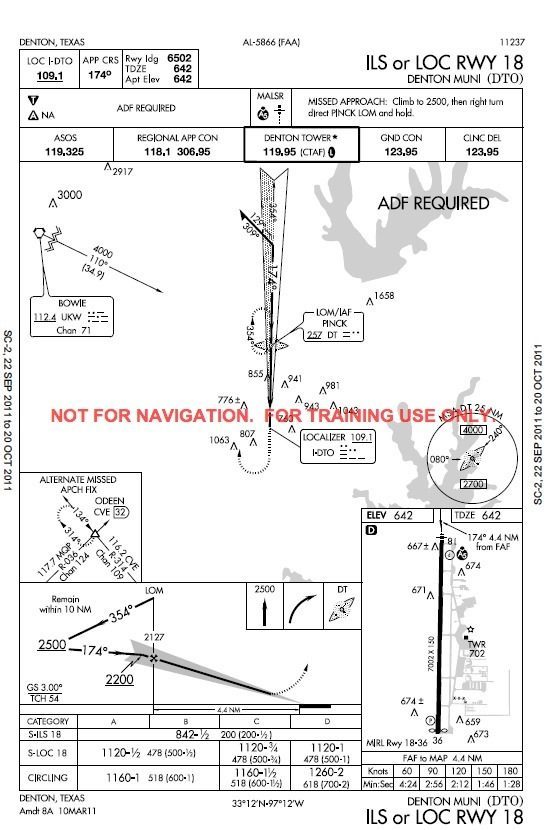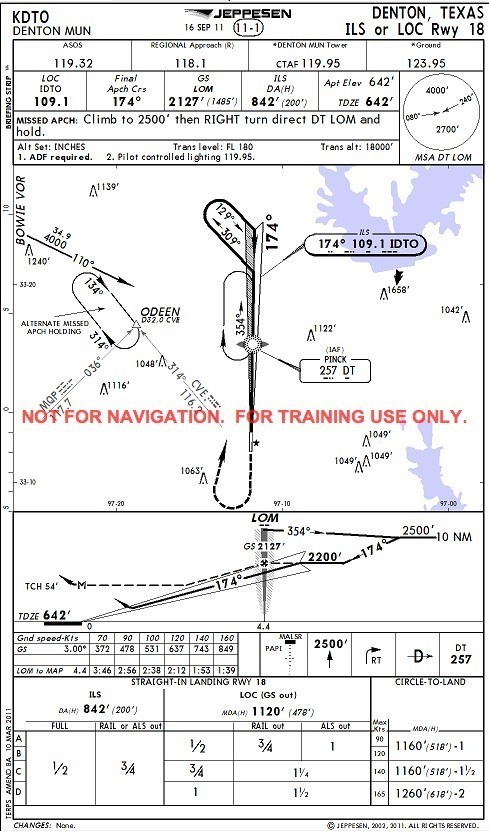High Performance Aviation
The Great Approach Plate Debate
By Hank Gibson, CFI, CFII, MEI
Walk into any pilot’s lounge at any airport, ask a few corporate pilots what the best instrument approach plates are, and you will get a pretty even cut down the middle of who prefers which plates. A lot of times, the Jepp guys are Jepp guys because their bosses pay for it. General aviation pilots, on the other hand, largely do not want to pay the high subscription fee, so they choose NACO. Well, I am here to present a breakdown of each, a few pros and cons, and a few opinions. I have used both extensively in my flying career, so I have grown familiar with both publications. (Note: The example approach used in this article is the ILS RWY 18 into KDTO, Denton, TX)
NACO Plates

The Good Points
Airport diagrams! It is very helpful to look down at the plate when the clouds are thick around the airplane and actually see what the airport looks like. Runway distances, displaced thresholds, and taxiways are all adequately marked.
If something specific is required for the approach (eg. the ILS 18 at DTO has an ADF requirement), it is printed on the chart in big, bold letters, making it very hard to miss (I would insert an old pilot joke here, but I’ll save that for another day).
In my opinion, the minimums section is better organized. There is a little more information than a Jeppessen plate, but I like the line by line itemization for the different minimums.
No searching for that one lousy updated approach! Just replace the whole book!
Did I mention a low cost? They can be printed for free off the FAA’s website or ordered in booklet format from a number of different companies online. A few different websites have subscriptions where a pilot can get his area plates sent to him every 56 days when the plates are officially updated.
The Bad Points
The notes section at the top can be crowded. It is not very evident on this particular approach, but if there are a significant number of notes, they are all published in one giant paragraph and it is hard to quickly scan them.
Other than an ILS approach, the rate of descent required for specific groundspeeds are not published directly on the approach. They can be found in the back of all the NACO booklets. I just tore the back page out of one of my old booklets and put it on my kneeboard. I always know where it is now and I do not have to flip pages.
If you buy one of the bound booklets, with the exception of tearing out the pages, it is actually quite a pain to keep the booklet open to the proper approach. In turbulence with things bouncing around, it can be even worse. The loose leaf booklets are nicer since it is easier to just pull an approach out and fly it.
The Conclusion
I myself actually prefer NACO charts, so I am slightly biased (and it’s not because of the Jepp cost, either. The flight school I work for has a subscription). The ease of updates, being able to print for free off the internet, and the overall set up just sits well with me. My eyes even enjoy the slightly dull grey paper even. Ahem; anyway, back to approach plates.
Jeppesen Plates

The Good Points
The overall flow of the chart is ideally set up. The frequencies are at the top, followed by relevant altitudes, missed approach, notes, and then the actual approach. It presents a nice, easy flow to brief the approach while loading all the information into the G1000.
The better organized notes section causes a whole lot less pilot grief. When getting bounced around in turbulence, it’s a lot easier to read bullet points then a whole paragraph.
Each approach has the descent planning section on the plate itself. This saves some excess time used in searching. Math still has to be done, but this way, all a pilot has to do is look at the plate rather than flipping through a book.
The Bad Points
Cost would be the first and biggest thing that comes to mind. For the full US, the price will run $787 a year. There are sections of the US that can be purchased for a lower price, but the cheapest was still $179 a year for the Pacific Northwest (jeppdirect.jeppesen.com). I’ll give a plug for printing costs here too, since I like to save trees.
The Conclusion
If you can afford it, go try the plates and see what you think. They work well and it is nice to be able to go to your computer, print the plate off you need and take it with you. It makes life pretty easy!
G1000 Technology
With the advent of modern technology, the Jeppesen plates are now available on newer G1000 installations. There is still the subscription fee, but having all the approach plates right there at your finger tips on the MFD whenever you need them is very handy. Like the iPad, it is also legal to use to shoot an instrument approach. No paper needed.
Personal Preference
Really, it all comes down to what you as a pilot like. Budget will play a lot into it too, but here is my opinion. I prefer NACO charts simply because when I take my plates with me in the airplane, I know that I have the plate for most any airport in the area. I do really like the paper, too.
Would you like more information?
Send us a message below.

